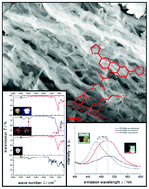Structurally stressed PT09SBA: A close look at the properties of large pore photoluminescent, redox active mesoporous hybrid silica†
Abstract
A thien-2-yl substituted, electron-rich

* Corresponding authors
a
Fachbereich Chemie, Technische Universität Kaiserslautern, Erwin-Schrödinger-Straße 54, D-67663 Kaiserslautern, Germany
E-mail:
thiel@chemie.uni-kl.de
Fax: +49 631 205 4626
Tel: +49 631 205 2752
b
Carl von Ossietzky University Oldenburg, Fakultät V, Institut für Chemistry, D-26111 Oldenburg, Germany
E-mail:
gunther.wittstock@uni-oldenburg.de
Fax: +49 441 798 3979
Tel: +49 441 798 3970
c
Institut für Organische Chemie und Makromolekulare Chemie, Heinrich-Heine-Universität, Universitätsstraße 1, D-40225 Düsseldorf, Germany
E-mail:
thomasjjmueller@uni-duesseldorf.de
Fax: +49 211 8114324
Tel: +49 211 8112298
d Friedrich-Alexander-Universität Erlangen-Nürnberg, Erlangen Catalysis Resource Center (ECRC), Egerlandstraße 3, D-91058 Erlangen, Germany
A thien-2-yl substituted, electron-rich

 Please wait while we load your content...
Something went wrong. Try again?
Please wait while we load your content...
Something went wrong. Try again?
M. Hemgesberg, B. Bayarmagnai, N. Jacobs, S. Bay, S. Follmann, C. Wilhelm, Z. Zhou, M. Hartman, T. J. J. Müller, S. Ernst, G. Wittstock and W. R. Thiel, RSC Adv., 2013, 3, 8242 DOI: 10.1039/C3RA23298K
To request permission to reproduce material from this article, please go to the Copyright Clearance Center request page.
If you are an author contributing to an RSC publication, you do not need to request permission provided correct acknowledgement is given.
If you are the author of this article, you do not need to request permission to reproduce figures and diagrams provided correct acknowledgement is given. If you want to reproduce the whole article in a third-party publication (excluding your thesis/dissertation for which permission is not required) please go to the Copyright Clearance Center request page.
Read more about how to correctly acknowledge RSC content.
 Fetching data from CrossRef.
Fetching data from CrossRef.
This may take some time to load.
Loading related content
